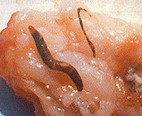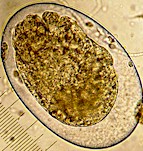Stephanurus dentatus, the pig kidney worm, is a roundworm species that affects swine and wild boars.
that affects swine and wild boars.
They are found in several tropical and subtropical regions, including North, Central and South America and parts of Asia and the Pacific.
In endemic regions prevalence can be very high (e.g. over 75% in southeast states of the USA). It affects mainly traditional pig farming and outdoor operations.
Occasionally it can infect cattle and donkeys. Dogs or cats are not affected
The disease caused by this worm is called stephanurosis.
Are pigs infected with Stephanurus dentatus contagious for humans?
- NO. The reason is that these worms are not human parasites.
You can find additional information in this site on the general biology of parasitic worms and/or roundworms.
Final location of Stephanurus dentatus
Predilection sites of adult Stephanurus dentatus are the kidneys and surrounding tissues.
Anatomy of Stephanurus dentatus

Adult Stephanurus dentatus are up to 5 cm long and about 2 mm thick, whereby females are always larger than males. They have a brownish color.
As other roundworms the body of these worms is covered with a cuticle, which is flexible but rather tough. The worms have no external signs of segmentation.
They have a tubular digestive system with two openings. They also have a nervous system but no excretory organs and no circulatory system, i.e. neither a heart nor blood vessels. Females can lay up to 1 million eggs daily! Males have two spicules for attaching to the female during copulation.
The eggs are ovoid, rather large (60x105 micrometers), with a thin shell and contain 32 or more cells.
Life cycle of Stephanurus dentatus
Stephanurus dentatus has a direct life cycle. The eggs are shed with the urine of the host. Young larvae in the environment hatch within 2 days and develop to infective L3 larvae within 4 days. These larvae can survive up to 5 months in a humid environment. However they does not support temperatures below 5°C.
Pigs become infected after ingesting such larvae. However, these larvae can also penetrate the skin of pigs. In addition, earthworms can also ingest larvae, which are transmitted to the pigs that eat the earthworms. These earthworms are not considered intermediate hosts because Stephanurus worms can complete development without the earthworms, and those larvae that are ingested by the earthworms are simply "collected" but do not develop further.
Larvae ingested by the pigs penetrate the gut's wall and migrate through the liver through the blood vessels. Those that penetrate the skin migrate through the connective tissue and the mussels to the blood vessels and than to the liver. After 1 to 2 months they reach the liver, where they remain for 3 months or longer, often encysted. Subsequently they migrate further to the kidneys across the peritoneum. Some larvae may also reach the lungs.
In the kidneys they produce cysts where they complete development to adult worms. Usually the cysts contain two worms, a male and a female. A small hole connects the cyst to the ureter or the renal pelvis to release the eggs. Egg production and shedding starts 10 to 15 months after infection (prepatent period). Infected piglets less than 5 months old acquired the infection before birth. Adult females live for up to 3 years inside the host.>
Harm caused by Stephanurus dentatus, symptoms and diagnosis
Migrating larvae are particularly harmful for the liver, the kidneys and sometimes the lungs as well. The harmed tissues are replaced by connective tissues (fibrosis), which impairs the physiological performance of the affected pigs. These results in a general herd problem, with poor performance and wasting. Significant economic damage is also due to rejection of damaged organs at slaughter: the kidneys, the livers and sometimes the lungs as well.
Severe infections cause loss of appetite and reduced weight gains. Cirrhosis (replacement of liver tissue by connectice tissue), peritonitis (inflammation of the peritoneum) and pleuritis (inflammation of the pleura, the lining of the lungs) can develop. Often a whole herd is affected by Stephanurus infections.
Diagnosis is based on the general symptoms and is confirmed through eggs detected in the urine. However, due to the long prepatent period, the disease can break out in a herd before eggs are shed in the urine. In these cases diagnosis can only be confirmed through necropsy after slaughter.
Prevention and control of Stephanurus dentatus
Systematic and thorough hygiene of all the facilities occupied by the pigs is the best preventative measure. Indoor housing is less supportive of larval development. Hard floors, particularly under the feeding troughs can help diminishing the worm population.
Numerous anthelmintics are effective against adult worms, e.g. several benzimidazoles (albendazole, fenbendazole, flubendazole, mebendazole, oxfendazole, etc.), levamisole, as well as several macrocyclic lactones (e.g. abamectin, doramectin, ivermectin, moxidectin), the latter are usually also effective against arrested larvae.
Depending on the country most of these anthelmintics are available for oral administration as feed additives or drenches. Levamisole and most macrocyclic lactones are usually also available as injectables.
There are so far no true vaccines against Stephanurus dentatus. To learn more about vaccines against parasites of livestock and pets click here.
Biological control of Stephanurus dentatus (i.e. using its natural enemies) is so far not feasible.
You may be interested in an article in this site on medicinal plants against external and internal parasites.
Resistance of Stephanurus dentatus to anthelmintics
So far there are no reports on resistance of Stephanurus dentatus to anthelmintics.
This means that if an anthelmintic fails to achieve the expected efficacy, chance is very high that either the product was unsuited for the control of Stephanurus dentatus, or it was used incorrectly.
|
Ask your veterinary doctor! If available, follow more specific national or regional recommendations for Stephanurus dentatus control. |